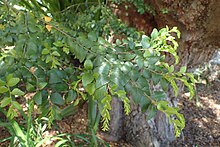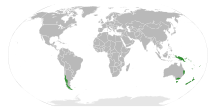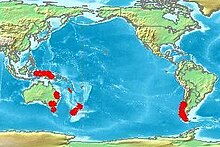Nothofagus
| Nothofagus Temporal range:
Late Cretaceousto recent | |
|---|---|

| |
| Nothofagus cunninghamii,Eastern Australia. | |
| Scientific classification | |
| Kingdom: | Plantae |
| Clade: | Tracheophytes |
| Clade: | Angiosperms |
| Clade: | Eudicots |
| Clade: | Rosids |
| Order: | Fagales |
| Family: | Nothofagaceae Kuprian.[1] |
| Genus: | Nothofagus Blume |

| |
| The range ofNothofagus. | |
| Synonyms[2] | |
| |



Nothofagus,also known as thesouthern beeches,is a genus of 43species[3]oftreesandshrubsnative to the Southern Hemisphere in southern South America (Chile, Argentina) and east and southeast Australia, New Zealand,New Guinea,andNew Caledonia.The species are ecological dominants in many temperate forests in these regions.[4]Some species are reportedly naturalised in Germany and Great Britain.[5]The genus has a rich fossil record of leaves,cupules,and pollen, with fossils extending into the late Cretaceous period and occurring in Australia, New Zealand, Antarctica, and South America.[6]
Description
[edit]Theleavesare toothed or entire,evergreenordeciduous.Thefruitis a small, flattened or triangularnut,borne in cupules containing one to seven nuts.
Reproduction
[edit]Many individual trees are extremely old, and at one time, some populations were thought to be unable to reproduce in present-day conditions where they were growing, except bysuckering(clonal reproduction), being remnant forest from a cooler time.Sexual reproductionhas since been shown to be possible.[7]
Taxonomy
[edit]The genusNothofaguswas first formally described in 1850 byCarl Ludwig Blumewho published the description in his bookMuseum botanicum Lugduno-Batavum, sive, Stirpium exoticarum novarum vel minus cognitarum ex vivis aut siccis brevis expositio et descriptio.[8][9]Nothofagusmeans "false beech", which Blume chose to indicate thatNothofagusspecies were different from beeches in theNorthern Hemisphere.[10]
In the past, they were included in the familyFagaceae,but genetic tests revealed them to be genetically distinct,[11]and they are now included in their own family,Nothofagaceae.[11]
Species list
[edit]The following is a list of species, hybrids and varieties accepted by thePlants of the World Onlineas of April 2023:[2]
- Nothofagus aequilateralis(Baum.-Bod.) Steenis(New Caledonia)
- Nothofagus alessandriiEspinosa(Central Chile)
- Nothofagus alpina(Poepp. & Endl.) Oerst.(Argentina South, Chile Central, Chile South)
- Nothofagus antarctica(G.Forst.) Oerst.(Argentina South, Chile Central, Chile South)
- Nothofagus balansae(Baill.) Steenis(New Caledonia)
- Nothofagus baumanniae(Baum.-Bod.) Steenis(New Caledonia)
- Nothofagus betuloides(Mirb.) Oerst.(Argentina South, Chile South)
- Nothofagus brassiiSteenis(New Guinea)
- Nothofagus carriiSteenis(New Guinea)
- Nothofagus cliffortioides(Hook.f.) Oerst.(New Zealand North, New Zealand South)
- Nothofagus codonandra(Hook.f.) Oerst.(New Caledonia)
- Nothofagus crenataSteenis(New Guinea)
- Nothofagus cunninghamii(Hook.f.) Oerst.(Tasmania, Victoria)
- Nothofagus discoidea(Baum.-Bod.) Steenis(New Caledonia)
- Nothofagus dombeyi(Mirb.) Oerst.(Argentina South, Chile Central, Chile South)
- Nothofagus flavirameaSteenis(New Guinea)
- Nothofagus fusca(Hook.f.) Oerst.(New Zealand North, New Zealand South)
- Nothofagus glauca(Phil.) Krasser(Chile Central)
- Nothofagus grandisSteenis(New Guinea)
- Nothofagus gunnii(Hook.f.) Oerst.(Tasmania)
- Nothofagus macrocarpa(A.DC.) F.M.Vázquez & R.A.Rodr.(Chile Central)
- Nothofagus menziesii(Hook.f.) Oerst.(New Zealand North, New Zealand South)
- Nothofagus moorei[F.Muell.) Krasser(New South Wales, Queensland)
- Nothofagus nitida(Phil.) Krasser(Chile South)
- Nothofagus nudaSteenis(New Guinea)
- Nothofagus obliqua(Mirb.) Oerst.(Argentina South, Chile Central, Chile South)
- Nothofagus perryiSteenis(New Guinea)
- Nothofagus pseudoresinosaSteenis(New Guinea)
- Nothofagus pulleiSteenis(New Guinea)
- Nothofagus pumilio(Poepp. & Endl.) Krasser(Argentina South, Chile Central, Chile South)
- Nothofagus resinosaSteenis(New Guinea)
- Nothofagus rubraSteenis(New Guinea)
- Nothofagus rutilaRavenna(Chile Central)
- Nothofagus solandri(Hook.f.) Oerst.(New Zealand North, New Zealand South)
- Nothofagus starkenborghiorumSteenis(Bismarck Archipelago, New Guinea)
- Nothofagus stylosaSteenis(New Guinea)
- Nothofagus truncata(Colenso) Cockayne(New Zealand North, New Zealand South)
- Nothofagus womersleyiSteenis(New Guinea)
- Nothofagus × apiculata(Colenso) Cockayne(New Zealand North, New Zealand South)
- Nothofagus × blairiiKirk(New Zealand North, New Zealand South)
- Nothofagus × dodecaphlepsMike L.Grant & E.J.Clement(artificial hybrid)
- Nothofagus × eugenananusGilland.(artificial hybrid)
- Nothofagus × leoniEspinosa(Chile Central)
- Nothofagus × solfuscaAllan(New Zealand North)
Subgenera
[edit]Four subgenera are recognized, based on morphology and DNA analysis:[12]
- SubgenusFuscospora,six species (N. alessandri, N. cliffortioides, N. fusca, N. gunnii, N. solandri,andN. truncata) in New Zealand, Tasmania, and southern South America.
- SubgenusLophozonia,seven species (N. alpina, N. cunninghamii, N. glauca, N. macrocarpa, N. menziesii, N. moorei,andN. obliqua) in New Zealand, Australia, and southern South America.
- SubgenusNothofagus,five species (N. antarctica, N. betuloides, N. dombeyi, N. nitida,andN. pumilio) in southern South America.
- SubgenusBrassospora(orTrisyngyne), 20 accepted species (N. aequilateralis, N. balansae, N. baumanniae, N. brassii, N. carrii, N. codonandra, N. crenata, N. discoidea, N. flaviramea, N. grandis, N. nuda, N. perryi, N. pseudoresinosa, N, pullei, N. recurva, N. resinosa, N. rubra, N. starkenborghiorum, N. stylosa,andN. womersleyi) in New Guinea and New Caledonia.
In 2013,Peter Brian HeenanandRob D. Smissenproposed splitting the genus into four, turning the four recognized subgenera into the new generaFuscospora,LophozoniaandTrisyngyne,with the five South American species of subgenusNothofagusremaining in genusNothofagus.[12]The proposed new genera are not accepted at theWorld Checklist of Selected Plant Families.[5][13]
Extinct species
[edit]The following additional species are listed as extinct:[6][14][15][16]
- †Nothofagus australis(Argentina, Early Oligocene-Early Miocene)
- †Nothofagus balfourensis(Tasmania, Late Oligocene-Early Miocene)
- †Nothofagus beardmorensis(Antarctica, Late Pliocene)[17]
- †Nothofagus bulbosa(Tasmania, Early Oligocene)
- †Nothofagus cethanica(Tasmania, Early Oligocene)
- †Nothofagus cooksoniae(Tasmania, Early Oligocene)
- †Nothofagus crenulata(Argentina, Mid Oligocene-Early Miocene)
- †Nothofagus cretacea(Antarctica, Late Cretaceous)
- †Nothofagus densinervosa(Argentina, Mid Oligocene-Early Miocene)
- †Nothofagus elongata(Argentina, Early Oligocene-Early Miocene)
- †Nothofagus glandularis(Tasmania, Mid Oligocene-Early Miocene)
- †Nothofagus glaucifolia(Antarctica, Late Cretaceous)
- †Nothofagus lanceolata(Argentina, Late Oligocene-Early Miocene)
- †Nothofagus lobata(Tasmania, Early Oligocene)
- †Nothofagus magelhaenica(Argentina, Early Oligocene-Early Miocene)
- †Nothofagus magellanica(Argentina, Late Oligocene-Mid Miocene)
- †Nothofagus maideni(Tasmania, Early Oligocene-Mid Miocene)
- †Nothofagus microphylla(Tasmania, Late Oligocene-Mid Miocene)
- †Nothofagus mucronata(Tasmania, Early Oligocene)
- †Nothofagus muelleri(New South Wales, Late Eocene)
- †Nothofagus novae-zealandiae(New Zealand, Mid-Late Miocene)
- †Nothofagus pachyphylla(Tasmania, Early Pleistocene)
- †Nothofagus palustris(New Zealand, Late Oligocene-Early Miocene)
- †Nothofagus peduncularis(Tasmania, Early Oligocene)
- †Nothofagus robusta(Tasmania, Early Oligocene)
- †Nothofagus serrata(Tasmania, Early Oligocene)
- †Nothofagus serrulata(Argentina, Mid Oligocene-Early Miocene)
- †Nothofagus simplicidens(Argentina, Mid Oligocene-Early Miocene)
- †Nothofagus smithtonensis(Tasmania, Early Oligocene)
- †Nothofagus tasmanica(Tasmania, Eocene-Early Oligocene)
- †Nothofagus ulmifolia(Antarctica, Late Cretaceous)
- †Nothofagus variabilis(Argentina, Oligocene)
- †Nothofagus zastawniakiae(Antarctica, Late Cretaceous)
Distribution
[edit]The pattern of distribution around the southernPacific Rimsuggests the dissemination of the genus dates to the time when Antarctica, Australia, and South America were connected in a common land-mass orsupercontinentreferred to asGondwana.[18]However, genetic evidence usingmolecular datingmethods has been used to argue that the species in New Zealand and New Caledonia evolved from species that arrived in these landmasses by dispersal across oceans.[19]Uncertainty exists in molecular dates and controversy rages as to whether the distribution ofNothofagusderives from the break-up of Gondwana (i.e.vicariance), or if long-distance dispersal has occurred across oceans. In South America, the northern limit of the genus can be construed asLa Campana National Parkand theVizcachas Mountainsin the central part of Chile.[20]
Evolutionary history
[edit]Nothofagusfirst appeared in Antarctica during the earlyCampanianstage (83.6 to 72.1 million years ago) of theLate Cretaceous.During the CampanianNothofagusdiversified and became dominant within Antarctic ecosystems, with the appearance of all four modern subgenera by the end of the stage.Nothofagusshows a progressive decline in the Antarctic pollen record through theMaastrichtian,before substantially recovering after theCretaceous-Paleogene boundary.[21]Nothofaguspersisted in Antarctica deep into the Cenozoic, despite the increasingly inhospitable conditions, with the final records from the lateNeogene,around 15-5 million years old, which were small tundra-adaptedprostrate shrubs,similar toSalix arctica(Arctic willow).[22]
Nothofagusfirst appeared in southern South America during the late Campanian. During the Paleocene and Eocene they were mostly restricted to southern Patagonia, before reaching a peak abundance during the Miocene. Their distribution contracted westwards during the late Miocene due to the aridification of Patagonia.[23]
Although the genus now mostly occurs in cool, isolated, high-altitude environments attemperateandtropicallatitudes,the fossil record shows that it survived in climates that appear to be much warmer than those thatNothofagusnow occupies.[24]
Ecology
[edit]Nothofagusspecies are used as food plants by thelarvaeofhepialidmothsof the genusAenetus,includingA. eximiaandA. virescens.Zelopsis nothofagiis a leaf hopper, endemic to New Zealand, which is found onNothofagus.
Cyttariais genus ofascomycetefungifound on or associated withNothofagusin Australia and South America.Misodendrumare specialist parasitic plants found on various species ofNothofagusin South America.[25]Additionally, the beetle,Brachysternus prasinus,has been known to live inNothofagus in Chile and in parts of Argentina. The geographic range of B. prasinus is highly dependent on the availability and distribution of Nothofagus on which B. prasinus is believed to feed. B. prasinus have been observed in the Nothofagus forests near the cities of Coquimbo and Llanquihue in Chile as well as the areas ofNeuquénand Chubut in Western Argentina.[26]
The species of subgenusBrassosporaare evergreen, and distributed in the tropics of New Guinea, New Britain, and New Caledonia. In New Guinea and New BritainNothofagusis characteristic of lower montane rain forests between 1000 and 2500 meters elevation, occurring infrequently at elevations as low as 600 meters, and in upper montane forests between 2500 and 3150 meters elevation.Nothofagusis most commonly found above theCastanopsis-Lithocarpuszone in the lower montane forests, and below theconifer-dominated upper montane forests.Nothofagusgrows in mixed stands with trees of other species or in pure stands, particularly on ridge crests and upper slopes. TheCentral Rangehas the greatest diversity of species, with fewer species distributed among the mountains of western and northern New Guinea, New Britain, and Goodenough and Normanby islands.[25]
The New Caledonian species are endemic to the main island (Grand Terre), most commonly on soils derived fromultramafic rocksbetween 150 and 1350 meters elevation. They occur in isolated stands, forming a low or stunted and irregular and fairly open canopy. The conifersAgathisandAraucariaare sometimes present as emergents, rising 10 to 20 meters above theNothofaguscanopy.[25]
Beech mast
[edit]Every four to six years or so,Nothofagusproduces a heavier crop of seeds and is known as the beechmast.In New Zealand, the beech mast causes an increase in the population of introduced mammals such as mice, rats, andstoats.When the rodent population collapses, the stoats begin to prey on native bird species, many of which are threatened with extinction.[27]This phenomenon is covered in more detail in the article onstoats in New Zealand.
References
[edit]- ^Angiosperm Phylogeny Group (2009)."An update of the Angiosperm Phylogeny Group classification for the orders and families of flowering plants: APG III".Botanical Journal of the Linnean Society.161(2): 105–121.doi:10.1111/j.1095-8339.2009.00996.x.hdl:10654/18083.
- ^ab"Nothofagus".Plants of the World Online - Kew Science.Retrieved19 April2023.
- ^Christenhusz, M. J. M.; Byng, J. W. (2016)."The number of known plants species in the world and its annual increase".Phytotaxa.261(3): 201–217.doi:10.11646/phytotaxa.261.3.1.
- ^Veblen, Thomas; Hill, Robert; Read, Jennifer (1996).Ecology and Biogeography of Nothofagus Forests.New Haven, CT: Yale University Press.ISBN978-0-300-06423-0.
- ^abKew World Checklist of Selected Plant Families
- ^abHill, Robert(2001). "Biogeography, evolution and palaeoecology of Nothofagus (Nothofagaceae): The contribution of the fossil record".Australian Journal of Botany.49(3): 321.doi:10.1071/BT00026.
- ^"Abstracts on Global Climate Change".cgi.cse.unsw.edu.au.Archived fromthe originalon 2008-01-07.
- ^"Nothofagus".Australian Plant Census.Retrieved21 April2020.
- ^Blume, Carl Ludwig (1850).Museum botanicum Lugduno-Batavum, sive, Stirpium exoticarum novarum vel minus cognitarum ex vivis aut siccis brevis expositio et descriptio.pp. 306–307.Retrieved22 April2020.
- ^Ryan, John Charles (2021-07-25).""Solitary in Your Rainy Kingdom:" Postcolonial Poetic Narratives of the Southern Beech ".Revista Interdisciplinar de Literatura e Ecocrítica.7(1): 5–28.
- ^abManos, Paul (1997)."Phylogenetic analyses of 'higher' Hamamelididae based on plastid sequence data".American Journal of Botany.84(10): 1407–1419.doi:10.2307/2446139.JSTOR2446139.PMID21708548.
- ^abHeenan, P.B.; Smissen, R.D. (2013)."Revised circumscription ofNothofagusand recognition of the segregate generaFuscospora,Lophozonia,andTrisyngyne(Nothofagaceae) ".Phytotaxa.146(1): 1–31.doi:10.11646/phytotaxa.146.1.1.
- ^Hill, RS;Jordan, GJ; Macphail, MK (2015). "Why we should retainNothofagus sensu lato".Australian Systematic Botany.28(3): 190–193.doi:10.1071/sb15026.S2CID83733526.
- ^Carpenter, RJ; Bannister, JM; Lee, DE; Jordan, GJ (2014). "NothofagussubgenusBrassospora(Nothofagaceae) leaf fossils from New Zealand: A link to Australia and New Guinea? ".Botanical Journal of the Linnean Society.174(4): 503–515.doi:10.1111/boj.12143.
- ^Jordan, GJ (1999)."A new Early Pleistocene species of Nothofagus and the climatic implications of co-occurring Nothofagus fossils"(PDF).Australian Systematic Botany.12(6): 757–765.doi:10.1071/sb98025.
- ^"Fossilworks: Nothofagus".www.fossilworks.org.Retrieved2022-12-04.
- ^Hill, R.S.;Harwood, D.M.; Webb, P.-N. (1996). "Nothofagus beardmorensis (Nothofagaceae), a new species based on leaves from the Pliocene Sirius Group, Transantarctic Mountains, Antarctica".Review of Palaeobotany and Palynology.94(1–2): 11–24.Bibcode:1996RPaPa..94...11H.doi:10.1016/S0034-6667(96)00003-6.
- ^"Native Forest Network (2003)Gondwana Forest Sanctuary".Archived fromthe originalon 2008-05-16.Retrieved2007-11-06.
- ^Knapp, M; Stockler, K; Havell, D; Delsuc, F; Sebastiani, F; Lockhart, PJ (2005)."Relaxed molecular clock provides evidence for long-distance dispersal ofNothofagus(Southern Beech) ".PLOS Biology.3(1): 38–43.doi:10.1371/journal.pbio.0030014.PMC539330.PMID15660155.
- ^C. Michael Hogan (2008)Chilean Wine Palm: Jubaea chilensis,GlobalTwitcher.com, ed. Nicklas StrombergArchived2012-10-17 at theWayback Machine
- ^Cantrill, David J. (2018),"Cretaceous to Paleogene Vegetation Transition in Antarctica",Transformative Paleobotany,Elsevier, pp. 645–659,doi:10.1016/b978-0-12-813012-4.00027-9,ISBN978-0-12-813012-4,retrieved2021-05-19
- ^Rees-Owen, Rhian L.; Newton, Robert J.; Ivanovic, Ruza F.; Francis, Jane E.; Riding, James B.; Marca, Alina D. (February 2021)."A calibration of cellulose isotopes in modern prostrate Nothofagus and its application to fossil material from Antarctica".Science of the Total Environment.754:142247.Bibcode:2021ScTEn.75442247R.doi:10.1016/j.scitotenv.2020.142247.PMID33254952.
- ^Pujana, Roberto R; Fernández, Damián A; Panti, Carolina; Caviglia, Nicolás (2020-12-31)."The micro- and megafossil record of Nothofagaceae from South America".Botanical Journal of the Linnean Society.196(1): 1–20.doi:10.1093/botlinnean/boaa097.ISSN0024-4074.
- ^Carpenter, RJ; Jordan, GJ; Macphail, MK;Hill, RS(2012). "Near-tropical early eocene terrestrial temperatures at the Australo-Antarctic margin, western Tasmania".Geology.40(3): 267–270.Bibcode:2012Geo....40..267C.doi:10.1130/G32584.1.
- ^abcRead, Jennifer; Hope, Geoffrey S. (1996)."Ecology of Nothofagus forests of New Guinea and New Caledonia".In Veblen, Thomas T;Hill, Robert S.;Read, Jennifer (eds.).The Ecology and Biogeography of Nothofagus Forests.Yale University Press. pp. 200–256.ISBN978-0-300-06423-0.
- ^Jameson, Mary Liz; Smith, Andrew B. T. (September 1, 2002)."Revision of the South American Genus BrachysternusGuérin-Méneville (Coleoptera: Scarabaeidae: Rutelinae: Anoplognathini: Brachysternina)".The Coleopterists Bulletin.56(3): 321–366.doi:10.1649/0010-065X(2002)056[0321:ROTSAG]2.0.CO;2.hdl:10057/3386.ISSN0010-065X.
- ^"Beech forest: Native plants".Department of Conservation.Retrieved26 August2012.
External links
[edit]- "NothofagusBlume ".Atlas of Living Australia.
